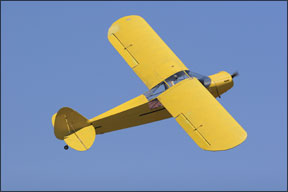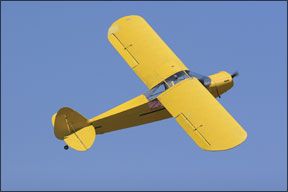Routine flight operations typically occur in steady or quasi-steady flight: the traffic pattern, normal climbs and descents, cruise flight, even turns. Yet for all its complexities, skillfully piloting an airplane requires that we strike a balance between just three pairs of performance-defining parameters. Two of these are the force 288 pairs lift and weight, and thrust and drag. Its a never-ending struggle to balance the weight of the airplane with lift, to balance the drag penalty resulting from that lift with thrust. For example, in climbing flight a portion of the airplanes own weight acts like drag, thereby increasing our thrust requirements. In descending flight, a portion of the weight acts to offset some of the drag penalty, reducing our thrust requirements. And in turning flight, we must stretch the vertical component of lift to balance weight. In the process, the emergent horizontal component of lift pulls the airplane to a new heading. But its the third performance pair that well focus on here: the energy pair known as pitch and power. Pitch is the tool we use primarily to manage our kinetic energy. As such, pitch changes manifest themselves as changes in airspeed, expressed in knots or mph as “V.” In upright flight for example, pulling on the elevator control always reduces airspeed; pushing always increases airspeed. Whether or not those actions result in a change in altitude as well depends on factors soon to be discussed. Its also important to separate momentary changes (e.g., a transient zoom) from the long-term consequences of your pitch inputs (e.g., the slow speed, high-angle-of-attack, rapid descent that usually follows the zoom). Power, on the other hand, is the tool we use primarily to manage our potential energy. The energy available to us is expressed as gallons of fuel remaining in the tanks and feet of altitude above the ground. Although horsepower is the traditional measure of power output, the more common cockpit representations are rpm, manifold pressure, gallons per hour and feet per minute. Figure 1, above, visualizes this concept. The Power Curve Diagram The power required for steady, level flight is tied to drag and speed and can be expressed as P
The relationship between the power required for level flight and the power available from a normally aspirated, reciprocating engine is expressed on a plot of power versus pitch (Speed) as in Figure 2, above. Realize, however, that all power curve diagrams like this one are snapshots frozen in time for a particular set of circumstances (i.e., weight, power setting, altitude, bank angle, airplane configuration). In his book Performance of Light Aircraft, physicist-pilot John T. Lowry enhances the traditional power curve diagram not only with plots of power available and power required, but also with a third plot showing excess power. Excess power is the difference between available power and required power (Pxs = Pav – Pre). As well see, including the plot of excess power allows several key operating speeds to be revealed on one convenient diagram.
The actual flight environment is fluid. The relationship of the various curves on a given power curve diagram will change as the stipulated conditions change. Important operating V-speeds will often change as well. For instance, we might construct a representative diagram for the following conditions: 85 percent of maximum gross weight, wings-level at sea level with full power available, in the clean configuration. Changing any of these conditions will change the power curves. Increasing the operating weight, or increasing the density altitude, or banking and turning, or extending the flaps and gear, or pulling the throttle back all shrink the airplanes climb envelope. At some bank angle, the airplane will be unable to climb at all. At the theoretical absolute ceiling (which is unattainable in practice), performance collapses to a single point only one combination of power and speed would be capable of sustaining wings-level flight. Anything else would result in a descent. This is diagrammed in Figure 3, on the preceding page.
Whether were piloting an airplane or a sailplane, kinetic and potential energies are exchanged continuously in flight. What differentiates the airplane from the sailplane, though, is the built-in power plant with access to fuel. Thus, the airplane pilot has more options in terms of the resources that can be exchanged, and at what rate: trade fuel for speed, or altitude for speed, or some of both. In some cases, we might be able to trade a surplus of speed for better climb performance; in other cases, we might actually have to increase speed in order to climb at a faster rate. Our job as pilots is to find the appropriate blend of pitch and power to accomplish the desired task.
V-Speeds Revealed
Key operating speeds can be found simply by drawing a few lines that intersect the different power curves at strategic points. For example, a horizontal line intersects the bottom of the power required curve at the maximum endurance speed, V
e (Figure 4, opposite page) This speed requires the least amount of fuel flowing through the engine to sustain level flight. Hence, well be able to remain aloft for the longest amount of time. Ve is generally quite slow just a few knots above the wings-level stall speed in some cases. Notice, too, that the power required for level flight increases on both sides of Ve: Slow below Ve and youll need more power; speed up above Ve and youll also need more power.A second horizontal line intersects the top of the excess power curve at the best rate of climb speed, V
y. The maximum differential exists between the available and the required power curves here; hence, the airplane will experience its greatest rate of climb for the given conditions. No matter which way the speed trend moves from Vy faster or slower your rate of climb will decrease.The dangers of the low-and-slow approach become readily apparent now vis–vis our power curve in Figure 5, above. As the airplane sinks below the desired approach profile, the natural instinct is to keep pulling the nose up. This typically occurs for two reasons: First, pulling momentarily appears to keep the runway in the desired spot in the windscreen; second, the pilot erroneously may be trying to control altitude with pitch. Throttle inputs usually either lag or are non-existent. The result: Airspeed continues downward, as does the airplane.
Should the speed dip to V
e, not only will the airplane be operating with little margin above the wings-level stall, but any further decrease in speed will then cause a rapid rise in the power required just to hold level flight, let alone eke out any semblance of climb. If reclaiming altitude quickly is critical, you must take advantage of the available power, and you must get the speed moving toward Vy. On a low-and-slow approach, this means advancing that throttle and pushing the nose downward so the airplane can accelerate toward maximum rate of climb. If this doesnt return you to the desired profile in time to land under control, at least youre moving in the right direction for your go-around.Off on a Tangent
The horizontal lines snapped onto our power curve diagram yielded two airspeeds that dealt with the time aspect of flight: maximum time aloft, and minimum time to climb to altitude (i.e., maximum rate of climb). If we now draw lines from our diagrams origin that are tangent to the curves of required and excess power as shown in Figure 6, we find two airspeeds that relate to distance: best glide airspeed, V
bg, and best angle of climb, Vx. These two particular speeds tie the airplanes vertical displacement to its horizontal displacement.In the case of a loss of power, our performance elements become lift, weight, drag and speed. All we can do is trade altitude for airspeed en route to landing. Pitching to V
bg maximizes glide range in zero wind conditions. Were operating at the airplanes best lift-to-drag ratio, thus maximizing our horizontal progress. From this standpoint, Vbg is analogous to best fuel economy (miles per gallon), except were burning altitude instead of fuel in a glide.V
bg maximizes our horizontal progress per foot of altitude lost; on the climb side, Vx maximizes our vertical progress per foot of horizontal distance traveled in no wind. Vx is handy any time we need to maximize our altitude by a given position downrange, e.g., a short field with obstacles on the departure end.Know Your Speed Limits
Superimposing vertical lines on the power curve diagram exposes several important speed limits. Starting on the left side of the diagram in Figure 7 (page 29), for instance, the first point of intersection of the available and required power curves denotes the theoretical minimum speed possible in level flight, V
m. Excess power is zero here. This speed, however, is unattainable unless operating at high altitude. In the more common low-to-moderate altitude environment, it is the aerodynamic limit of the wing that will determine our lower speed limit. Of course, were talking about the power on stall speed, Vs. Most power curve diagrams cut off at Vs since anything slower is not practically possible.The right-most intersection of the available and required power curves defines the maximum continuous level flight speed, V
h. Just like the point for Vm, excess power is zero at Vh. Yet Vh is not the fastest speed possible in an airplane Vne sits farther off to the right.Of course, speeds between V
h and Vne are only achievable in descending flight. And to fly faster than Vh in airplanes with fixed-pitch propellers likely requires a power reduction to keep from exceeding engine/prop limits as you pitch for more speed.Also, merely asking, “How fast can an airplane go?” is not the same as asking, “How fast can it go in level flight?” The Reno Air Races, for example, are not contests to see who can fly the fastest. If they were, then those airplanes that can accelerate to the highest speed in a dive without breaking up would be the winners. Instead, the Reno Air Races reward airplanes that can sustain the fastest speeds in essentially level flight. Maximizing V
h is the challenge. Racers employ strategies to increase horsepower and reduce drag to increase the top speeds available around the course at Reno-Stead.Beyond the Basics
Once these power curve fundamentals are understood and with them the proper assignment of pitch and power controls we can delve deeper into airplane performance. Remember that a power curve diagram captures a specific moment in time and space. Moreover, the traditional classroom diagram accounts neither for the variable efficiencies of the engine and prop, nor the effects of the wind. So although published best glide and best angle of climb speeds might be valid at maximum gross weight in calm conditions, the operational V
bg and Vx speeds may need some adjustment.The Columbia 300 and the Cessna 150, for example, share a best glide ratio of roughly 9.5 to 1. At maximum gross weight, the 300 glides at 106 knots whereas the 150 glides at 60 knots. Yet with all other things being equal, both airplanes will reach the same landing site in calm wind. The Columbia will just arrive sooner.
For better performance into a strong headwind, for instance, we should glide at a speed somewhat faster than V
bg, but climb over obstacles at a speed somewhat slower than Vx. With a strong tailwind, we should glide somewhat slower than Vbg, but climb over obstacles somewhat faster than Vx (better yet, avoid taking off downwind toward obstacles whenever possible!). Other V-speeds may need to be adapted to the actual flight conditions, too.Real-life performance is nuanced. In the end, however, all discussions about the relationship between pitch and power must remain rooted in the aerodynamic principles clearly conveyed by the power curve. The bottom line in-flight is this: Pitch for the speed you need; power for the desired altitude profile. Violate this unambiguous law at your peril.




